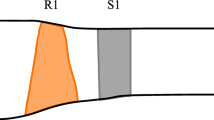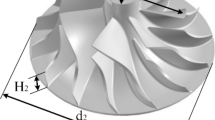Abstract
The design of jet engine compressor blading always implies a compromise between design and off-design operation. The reason for this is a fixed blade geometry which has to be operated over a wide range of operating conditions. Consequently, maximum achievable efficiencies at design operation are limited by off-design requirements, e.g., a certain stall margin. This paper describes an approach using shape-variable blades equipped with integrated piezoceramic-based macro fiber composite (MFC) Actuators on the blade’s suction and pressure sides. By applying a voltage to these actuators, it is possible to increase and to decrease the blade stagger angle and therefore the blade turning. Compared to a conventional fixed blade profile, the actuated design is thus adaptable within a certain range regarding ambient conditions. The first part of the paper describes the geometry and structure of the shape-variable blades for use in a compressor cascade experiment. In the next part, the three-dimensional deformation behavior of all manufactured blades at different shape conditions is characterized with a photogrammetric measurement system called ATOS. The first results without aerodynamic loads show an average displacement at the trailing edge of approximately Δz ≈ 0.9 mm compared to the non-actuated condition. This corresponds to an average outlet angle variation of approximately ∆κ2 ≈ ± 1°. The third part of the paper presents the results of the low speed cascade experiment using a fully actuated cascade. On the one hand, the objective is to determine the influence of blade actuation on aerodynamic characteristics such as flow outlet angle, total pressure loss and pressure distributions. On the other hand, optical blade displacement measurements are used to investigate combined 2D- and 3D-deformation effects of blade actuation in conjunction with aerodynamic loads. For these measurements, the ATOS system is also used. The wake evaluations show that maximum blade actuation leads to flow outlet angle deviations up to ± 1° which can be described by an almost linear shift of the cascade performance without changing the loss distribution significantly. Furthermore, for the chosen profile this margin is approximately constant over the operating range.




















Similar content being viewed by others
Abbreviations
- AoA:
-
Angle of attack
- GFRK:
-
Glass fiber reinforced plastic
- VSV:
-
Variable stator vanes
- cp :
-
Pressure coefficient
- h:
-
Blade span (mm)
- l:
-
Chord length (mm)
- Ma:
-
Mach number (–)
- n:
-
Rotational speed (min−1)
- q:
-
Dynamic pressure (Pa)
- s:
-
Standard deviation (μm)
- t:
-
Blade pitch (mm)
- w:
-
Flow velocity (m/s)
- x:
-
x-coordinate of ATOS-measurements (mm)
- y:
-
y-coordinate of ATOS-measurements (mm)
- z:
-
z-coordinate of ATOS-measurements (mm)
- xC :
-
x-coordinate of cascade (mm)
- yC :
-
y-coordinate of cascade (mm)
- zC :
-
z-coordinate of cascade (mm)
- Δz:
-
Displacement variation in z-direction (mm)
- B:
-
Flow angle (°)
- βS :
-
Probe angle (°)
- Δβ:
-
Blade turning (°)
- ζV :
-
Total pressure loss (–)
- κ:
-
Blade angle (°)
- Δκ:
-
Blade angle variation (°)
- λ :
-
Stagger angle (°)
- Δλ :
-
Stagger angle variation (°)
- σ:
-
Solidity (–)
- ϕ:
-
Camber angle (°)
- 1, 2:
-
Stations
- REF:
-
Reference condition/blade
- MAX:
-
Maximum stagger angle condition
- MIN:
-
Minimum stagger angle condition
- AL:
-
Aerodynamic loading (windtunnel “on”)
- LE:
-
Leading edge
- MFC:
-
Macro fibre composite
- pp:
-
Peak-to-peak
- TE:
-
Trailing edge
References
Rolls-Royce: The Jet engine. s.l. Renault Printing Co Ltd, Schrifttum (1996)
Monroe, R.C: Consider variable pitch fans. Houston, Texas. Hudson Products Corp
Mazzawy, R. S: Performance study for benefits of variable pitch composite fan. s.l. Proceedings of ASME Turbo Expo 2010 (2010)
Forecast International: “Ducted-Prop/Propfan Technologies”, Archieved 3/2000 (1999)
Violette, J. A., Loss, E. S.: Mechanical design of variable pitch fan for turbofan engines, Proceedings of ASME Turbo Expo 2010, GT2010-22969 (2010)
Müller, T., Lawerenz, M.: Shape adaptive airfoils for turbomachinery applications undergoing large deflections, 44th AIAA/ASME/ASCE/AHS Structures, Structural Dynamics and Materials Conference, Norfolk (2003)
Müller, T., Dipperz.: Entwicklung und experimentelle Untersuchung einer formvariablen Turbomaschinenschaufel, Fortschritt-Berichte VDI, Vol. 7, Nr. 482, VDI Verlag (2006)
Monner, H.P.: Realization of an optimized wing camber by using form variable flap structures. Aerosp. Sci. Technol. 5(7), 1270–9638 (2001)
Hammer et al.: Active flow control by adaptive blade systems in periodic unsteady flow conditions, https://depositonce.tu-berlin.de/bitstream/11303/197/2/HammerPhanPeterWerderMeyerLiebichThamsen2014afcc.pdf
Van de Kamp, B.: Konzeptstudie: Strukturkonzept adaptiver Beschaufelungen für Turbofan-Triebwerke, Diploma Thesis, TU Braunschweig (2012)
Monner, H.P., Huxdorf, O., Riemenschneider, J., Keimer, R.: Design and manufacturing of morphing fan blades for experimental investigations in a cascaded wind tunnel, 23rd AIAA/AHS adaptive structures conference. Kissimmee, Florida (2015)
Huxdorf, O.: Auslegung und Bau von Schaufeln mit variabler Wölbung für den Test im Gitterwindkanal, Diploma Thesis, Otto-von-Guericke-University Magdeburg (2013)
Riemenschneider, J., Huxdorf, O., Opitz, S.: Effects of piezoceramic actuator in quasistatic use, ASME International Conference on Smart Materials, Adaptive Structures and Intelligent Systems, ASME, Newport, Rhode Island, USA (2014)
Schur, F.: Experimentelle Untersuchung einer adaptiven Verdichterbeschaufelung im Gitterwindkanal. Studienarbeit, TU Braunschweig (2015)
Author information
Authors and Affiliations
Corresponding author
Additional information
This paper is based on a presentation at the German Aerospace Congress, September 22-24, 2015, Rostock, Germany.
Rights and permissions
About this article
Cite this article
Krone, J.H., Huxdorf, O., Riemenschneider, J. et al. Experimental investigation and design of a shape-variable compressor cascade. CEAS Aeronaut J 8, 105–127 (2017). https://doi.org/10.1007/s13272-016-0224-1
Received:
Revised:
Accepted:
Published:
Issue Date:
DOI: https://doi.org/10.1007/s13272-016-0224-1


























